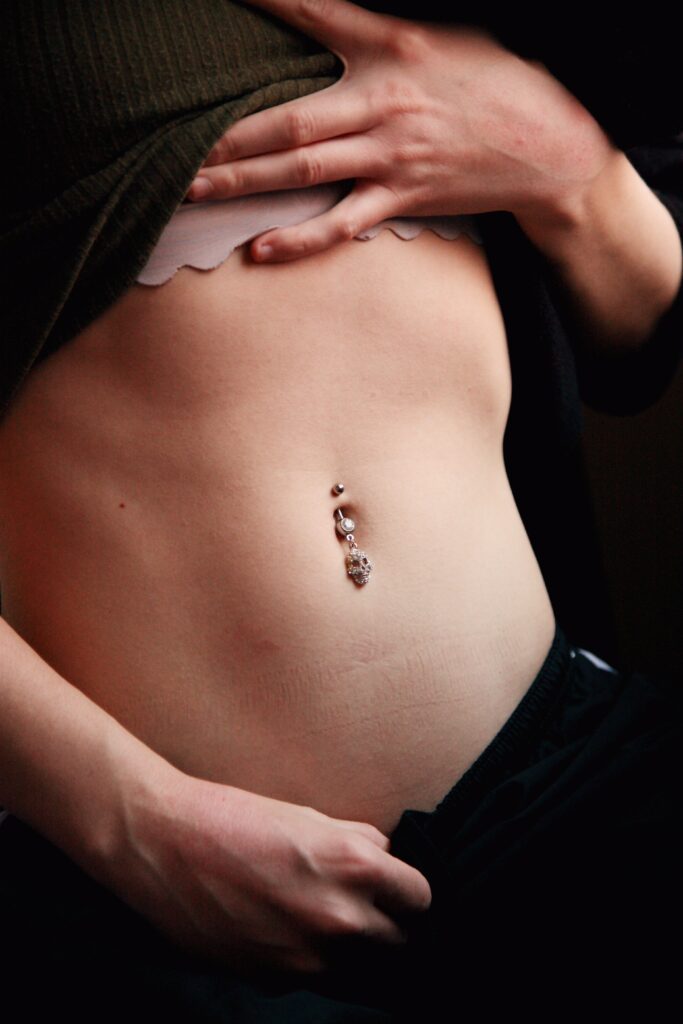Table of Contents
Now, if you’re here, you’re probably wondering: “Why, oh why, is my adorable belly bling seeping like a forgotten faucet?” Well, that’s belly button piercings for ya. Glamorous as a Hollywood starlet one day, a leaky sink drama the next. But hey, keep your tattoos on, kiddos, we’ve got the 411 on your bloody 911.

As many of us in the body modification community will tell you, the adrenaline rush doesn’t end when you walk out of the parlor with a brand-new twinkle in your navel. It’s a relationship—a commitment, if you will—that requires time, patience, and a whole lot of aftercare. And let’s not forget the moments of panic when your sparkling new friend decides to bleed a bit. Ah, the joys of body adornment!
Is Bleeding Normal During the Procedure?

First things first, let’s get real—piercings bleed. We’re puncturing your skin, after all. It’s an elegant dance of needle and flesh. And like any good dance, there’s the chance for a toe to be stepped on. Expect some bleeding, bruising, and discomfort during and immediately after the procedure. Nothing to panic about, my friends—it’s all part of the body’s healing process. It can feel like an extended performance, going on for a few days or even a couple of weeks, depending on how diligent you are with your aftercare routine.
Belly Button Piercing Bleeding During Healing
Speaking of aftercare, let’s talk about bleeding during the healing process. Yes, it can happen, and no, it’s not the end of the world. After the belly button piercing, a little bleeding is quite normal as your body works hard to mend the puncture. The key word here is ‘little.’ If your navel’s putting on a horror show, it’s time to consult your piercer or doctor.
Why Is It Bleeding?

Now, I remember a week after my second navel piercing, I woke up to find a spot of dried blood on my shirt. I nearly had a heart attack! Then I realized it’s because I had bumped my belly against the counter the night before. An unfortunate encounter, but no infection. However, if you find dried blood around your piercing weeks after you’ve had it done, and there’s no clumsy encounter to blame, it could be a sign of infection.
Infections are like uninvited party crashers – annoying and a total mood kill. However, the good news is they can usually be evicted easily with antibiotics. But if you suspect a more serious infection, or your body’s showing signs of rejecting the piercing, it’s better to let it go and allow your body to heal.
How Long Will It Take To Heal?

As for healing, don’t expect your piercing to turn into a well-behaved, hassle-free adornment overnight. The piercing process might be over in a jiffy, but healing can take between six months to a year. It’s a journey, a long and winding road to recovery. There will be scabs, maybe big, maybe small. They’re your body’s way of saying, “Hey, I’m working on it!”
What Can You Do to Help it Heal?
One thing that helped my belly button piercing heal faster was keeping it clean and avoiding unnecessary irritation. Regular saline solution cleanses, short showers instead of baths, and loose-fitting clothes were my best friends. Once, I even sported a stylish eye patch over it to prevent my clothes from rubbing against it. Trust me, looking like a pirate with a belly button secret was worth it!
How About Piercing Rejection
But what if your body decides to reject your belly button piercing? While it’s rare, it can happen. However, bleeding is usually not a symptom of piercing rejection. Look out for flakiness, peeling, redness, irritation, or if it looks like your jewelry’s taking a little walk away from its original home.

In the end, remember this: each body is unique and responds differently to piercings. But with a dash of patience, a pinch of care, and a whole lot of love for your body, you’ll make it through the navel-piercing journey. So, here’s to belly button bling and the unforgettable stories they bring!
Conclusion
Now that we’ve navigated the sometimes choppy waters of belly button piercings, it’s time to wrap this conversation up, my dear comrades of the body art brigade. A navel piercing is more than just a glittering accessory—it’s a statement, a journey, and a testament to your individuality. When choosing where your new shiny companion will reside, remember that everyone’s anatomy is unique. Seek advice from a professional piercer, someone who can guide you towards a placement that will best flatter your form and allow for a healthy healing process.
Now, let’s talk dollars and cents. As with most things in life, you get what you pay for. Belly button piercings can range from $30 to $70, sometimes even up to $100, depending on the reputation of the shop and the skill of the piercer. However, this isn’t the time to bargain hunt, my friends. Safety, cleanliness, and professional expertise are worth every penny.
Let’s not ignore the elephant in the room, though. Belly button piercings, like any form of body modification, come with potential risks. We’ve discussed infections, bleeding, and the possibility of rejection. But with diligent aftercare, most issues can be nipped in the bud. However, don’t forget to listen to your body. If something doesn’t feel right, seek medical help promptly. After all, body art is about celebrating our bodies, not compromising their wellbeing.
To put it in a nutshell, a belly button piercing is a thrilling adventure into the world of self-expression, but it requires commitment, care, and a whole lot of love for your body. Because, at the end of the day, we’re not just decorating our bodies—we’re celebrating them. So, here’s to safe piercing, mindful healing, and the joy of donning your very own belly button bling!

Tori Jones
Born and raised in a small town by the coast, my passion for art was ignited at a young age! I honed my skills in painting and spent countless hours in my bedroom, bringing my creative visions to life. After studying Fine Arts, I pursued my dream and made my way to London where I was introduced to the world of tattoos. The ability to create art and bring it to life on someone's body was nothing short of captivating. I immediately knew then that was my calling and with relentless passion and dedication, I persevered connecting with some of the best tattoo artists in London. Through their expert knowledge and guidance, I mastered the art of tattooing and here I am today, living my dream!